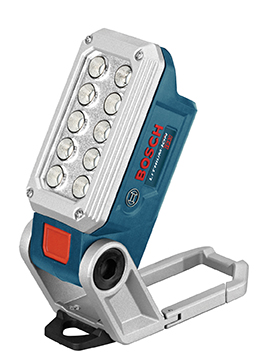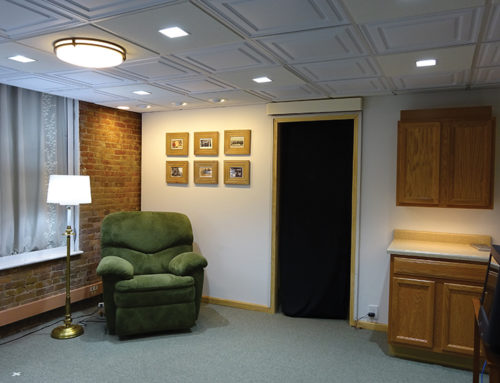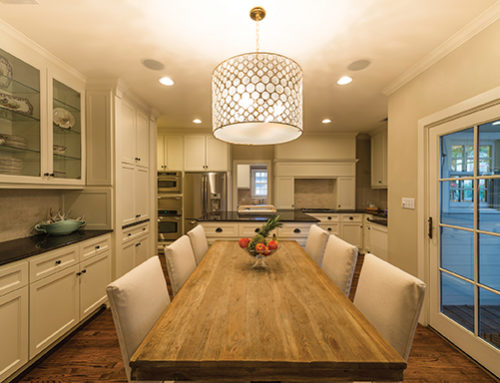The Light-emitting diode (LED) seems to be everywhere, including in tiny keychain flashlights, conventional flashlights that emit powerful beams, general service lamps, replacement fixtures for commercial use, and portable work lights.
Tool manufacturers and lighting companies offer an impressive selection of work site lighting options, from flashlights to compact, lithium-ion powered work lights to light towers and strings of LED fixtures to illuminate large areas.
For this report, toolmakers Bosch, Makita and Milwaukee Tool, as well as lighting specialists Larson Electronics and Molex, discuss LED work lights and the benefits of using this technology.
Higher cost once was a barrier to increased LED lamp usage, but prices have lowered significantly. In addition, LED proponents argue that savings from longer life and reduced power consumption offset the cost difference.
About the technology
The biggest advantage LEDs have over traditional work lights is durability, said Jeremy Blankenship, lighting designer for Larson Electronics, maker of LED work lights that range from flashlights to LED light towers.
“With gas-burning lamps, there always is a glass lamp that can be broken due to rough handling, dropping the work light, impacts or vibration,” Blankenship said. “With filament-style traditional lamps, the filament itself is highly susceptible to impacts and vibrations that may sever the filament, which can result in premature lamp failure while the glass lamp remains intact. With LED solid-state technology, these recurring issues are resolved. LED work lamps make for a more reliable and stable work light, reducing maintenance and downtime within the work field due to lamp burnouts.”
LED technology is highly efficient and provides the same output at a lower wattage than traditional lighting fixtures, while providing an increased lamp life.
“Incandescent and halogen lamps are very inefficient and have a very short lamp life,” Blankenship said. “Fluorescent and compact fluorescent lamps are an improvement over incandescent and halogen lamps but still fall short when compared to LED lighting. With LED work lights, an operator is able to obtain the same light output or increased light output over the previous traditional lighting. These LED light sources decrease electrical consumption, which results in low electrical bills in line voltage work lamps and increased battery run time in rechargeable work lights. And, they obtain a light source that lasts 50,000-plus hours, which is double the lifespan of fluorescent, metal halide and high-pressure sodium lamps.”
Safety is another benefit.
“All light sources generate heat,” Blankenship said. “Traditional work lamps, such as the common 500W quartz work lights or 100W incandescent drop lights, reach high surface temperatures, which introduce a burn risk to anyone that allows prolonged skin contact with the light source, as well as a fire hazard if a flammable material is accidentally set too close to the light source for an extended period of time. While LED fixtures do produce heat, they are designed with heat sinks to properly disperse the heat.”
Beyond safety, high upfront costs have been a drawback for LEDs. However, LED prices have dropped.
“Within the last 5 to 10 years, LED technology has made significant advancements in efficiency for light output as well as price point,” Blankenship said. “This has allowed manufacturers of LED work lights to pass these cost savings to customers. With higher efficacy in light output for LED fixtures and higher efficiency in cost of manufacturing, LED work lights are becoming readily affordable to be used in the work place and [to] replace traditional work lamps.
“For now, LED lamps will still be more expensive than bottom-dollar incandescent lamps, but there are countless cost savings in the long run with the LED fixture, resulting in a return on investment and making the LED product the cheaper buy over a period of time,” he said.
Molex manufactures LED fixtures to illuminate large industrial environments for construction and maintenance.
“This is an exciting time for LED fixtures in industrial environments,” said Tom McCollum, Molex global product manager. “We still are in the early stages of adoption with new technology coming out every day, making LEDs more affordable, more efficient and with higher and higher levels of performance. Historically, we have had lighting designs that remain unchanged for years or decades, but those days are over.”
For industrial work environments, the primary benefit is that LED light sources are inherently more durable than traditional light sources, McCollum said.
“That increased durability and very long life for LED light sources means that the need to maintain LED fixtures is greatly diminished,” he said. “Instead of breaking an incandescent filament during rough handling or having to replace a traditional light source after just a few weeks or months of use, LED fixtures can withstand the rough handling and can last for years. Additionally, for fixtures of similar light output, LED versions run much more efficiently than fixtures with more traditional light sources, such as incandescent or various HID lamps. One LED series of products is rated Class I, Division 2, for use in hazardous environments.”
There are a few drawbacks, but most are easily rectified.
“LEDs tend to act as a point source but are usually focused in one direction [e.g., in an area that is less than 180 degrees] and thus may need to be managed to ensure emitted light is directed in the desired locations,” McCollum said. “Getting the fixture to produce bidirectional or omnidirectional or even tightly focused beams of light can be achieved by utilizing multiple LEDs within the fixture that are oriented in different directions or by using lenses and diffusers to direct the light in the desired directions.
“LED fixtures typically cost more up front yet save money over the years by minimizing maintenance and operating costs simply due to the reduced power consumption of the LED fixture,”.




